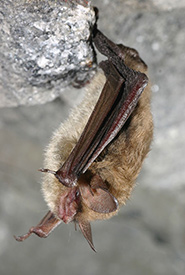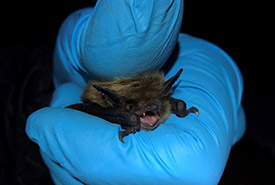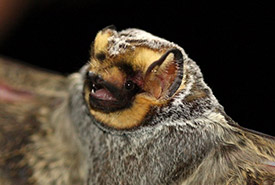A reckoning with bats

Northern long-eared bat (Photo by Al Hicks, New York State Department of Environmental Conservation)
Well folks, it’s that magical time of year once again.
The leaves are changing colour, the air is crisp and decorations are making their annual migration from the basement to the lawn. Indeed, fall is here, and Halloween is right around the corner.
This is the season of pumpkins, candy and spooky stories — a time when a werewolf lurks around every corner and the early setting sun hides ghouls in the deepening shadows. And it is from those shadows that another creature emerges, wings flapping in the dark. Like the inflatable pumpkins that make their way to the lawn, bats are making a migration out of annual obscurity, and into the forefront of our minds.
My first encounter with bats took place when I was eight years old, as I first read Bill Waterson’s Calvin and Hobbes comic strip about a young student’s science presentation on bats. Calvin describes bats as having ”glowing red eyes and glistening fangs” and being ”unspeakable giant bugs.” That story left me wondering what the actual deal was with bats. Not long afterward, I found a dead bat between window panes at a friend’s cottage. For over a decade, my understanding of bats was split between those two experiences.
If I had to bet, I’d guess that your experience is similar to what mine was growing up. A relative’s story of a terrifying bedroom bat encounter, a movie scene you’d rather forget or the distant memory of what Dracula allegedly looks like. It’s hardly surprising that our experiences are limited to these second-hand moments. After all, many bats are small, nocturnal creatures and frankly wouldn’t much like to get to know you, either.
But then October rolls around, and suddenly we’re all reminded about these fascinating, flying mammals. And consciously or not, we need to reckon with how much (or little) we actually know about them.
My unscheduled reckoning came in 2018 when I was unexpectedly offered a master’s position through the University of Waterloo to study the roosting behaviour of bats on Prince Edward Island. My first thought was “that sounds awesome” and my second was “wow, I really don’t know anything about bats.” Knowing little but feeling full of curiousity, I signed on the dotted line and soon found myself flying across the country, pulling on a headlamp and walking out into the chilly darkness.

A night of bat research looks like numb hands, tired eyes and full hearts (Photo courtesy of Evan Balzer)
Suddenly, urgently, I heard the whisper: “We got one.” And there was my colleague Julia nervously pulling a tiny brown lump out from the Tuttle trap (read: a giant harp with a collection bag beneath — the bats bounce off the strings and safely land in the bundle beneath). I’ll never forget the energy that night: a handful of grad students and our supervisor, Hugh, deftly demonstrating how to handle a tiny, grumpy bat. It was the intersection of passion, curiosity and profound appreciation for what used to abstract: a blur in the night, some data in academic journals, stories from family, comic book laughs.
So what does it feel like when everyone’s old conceptions about bats are being blown wide open all at once? At midnight? On a Tuesday?
It feels something like numb hands, tired eyes and full hearts.
Merlin Tuttle, renowned bat researcher whom I met briefly at a conference (remember the Tuttle trap?), told me that the biggest issue in bat conservation was the way we perceive them. And he meant it literally. When he set about saving a millions-strong bat colony living under a Texan bridge in 1984, he used portrait photography strategies to frame bats in a friendlier light. And this concept rings true today as well.
This October, as the fluttery wings descend, here’s what I think we should keep in mind:

Little brown bat (Photo by Evan Balzer)

Hoary bat (Photo by J.N. Stuart)
First, bats are beautiful. I’m not kidding, check these cuties out:
Second, they aren’t out to get you. One story I often hear when talking about bats is how they swoop down to attack people. From bats trapped inside houses, to others free in the night sky, folks often report bats winging down around their heads. But the truth of it is those bats don’t have any interest in you; they’re just doing what they were born to do.
To understand the bat trapped indoors, we need to understand bat flight mechanics. All things considered, bats are not the best fliers. Becoming airborne is hard, and flight is a lot of work. So when bats need to lift off, they often do so from a high point, and then fall into flight, gaining momentum as they do so. Thinking back to the bat swooping around a living room, that’s probably just a confused animal trying to pick up enough speed to get out of a sticky situation.
And outdoors? Because Canadian bats are insectivores, they’re almost certainly just out looking for a snack. And if you’re standing near their roost access at dusk, the swooping you experience is probably just what I described above: a bunch of bats heading out for a night of foraging at nearby forests or ponds. Although the risk of contracting rabies is real, remember that bats would really rather avoid you, too. If you take precautions to never touch a trapped bat, you’ve done your part to keep safe.
The scariest thing to me about bats is the dangers they’re facing from a pandemic of their own. In North America, many species are declining in huge numbers from the impacts of white-nose syndrome, a disease caused by an invasive fungus. Since 2006, millions of bats have died from this disease, and its inevitable spread will lead to the deaths of many more. As a bat biologist, I worked to understand the impact of this disease in Canada, and some of the ways bats use human buildings to persist.
Not everyone can be a bat biologist, nor should they. But everyone can continue to examine their worldview about the nature around us. This Halloween, I encourage you to think differently about bats. Appreciate their beauty. Consider their biology. And be on the lookout for them in your neighbourhood. When the fear is wiped away, all that’s left to do is look up and wonder at these fascinating flying friends
Even though I don't currently work with bats at the Nature Conservancy of Canada, that hasn't stopped me from sharing my passion for them. And if you'd like to hear more about these and other misunderstood animals, join me on October 27 as I host a discussion with a panel of speakers who will walk us through fact from fiction and help us understand how our perceptions impacts species survival.


